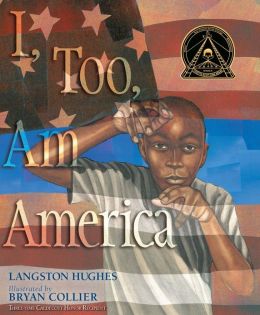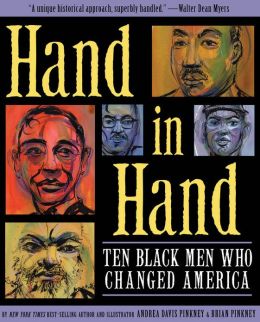I know—Black History month just ended. I’m not a fan of segregated “histories”: in case you haven’t noticed, this is the first day of Women’s History Month and we’ll have a chance to celebrate Hispanic Heritage Month beginning in mid-September, which overlaps with LGTB History month in October, which is also Filipino American History Month. Can we just say every month is human history month?
Of course that’s problematic too, simply because there’s so much history. And I agree that many marginal groups have been slighted by the record and young people need role models they can identify with. That’s one purpose of the Coretta Scott King Award, given each year by the ALA for outstanding children’s books that reflect the black experience. Today we look at the winners in the illustration and text category, plus a welcome addition to the field of history.
I Too Am America, by Bryan Collier, based on a peom by Langston Hughes. Simon & Shuster, 2012, 32 pages.  Age/interest level: 8-12.
Age/interest level: 8-12.
Here is the poem in its entirety:
I too sing America./I am the darker brother./ They send me to eat in the kitchen when company comes,/ but I laugh, and I eat well, and grow strong./ Tomorrow, I’ll be at the table when company comes./ Nobody’ll dare say to me, “Eat in the kitchen” then. Besides/ they’ll see how beautiful I am and be ashamed./ I too am America.
It was written in the days when the highest opportunity a young black man could aspire to was a career as a Pullman porter. Collier shows the young man cheerfully turning down berths and cleaning up after passengers. He’s a man in the shadows, barely regarded. But he’s passing on learning and knowledge, represented by the books, fliers and newspapers he gathers on the train and throws off the back of the train. In a two-page spread we see this dissemination of knowledge reaching his people and expressing itself in music, sports, poetry and art—fluttering down through generations as the darker brothers slowly emerge from the shadows. The collage and acrylic technique is worth a close look, but be sure to compare each page with the Illustrator’s Note to see just how this poem was interpreted symbolically and graphically. After that, try choosing a short poem and giving it a similar treatment.
- Worldview/moral value: 4.5 (out of 5)
- Literary value: 4
Hand in Hand: Ten Black Men Who Changed America, by Andrea Davis Pinkney. Walk in the Sun Books  (Disney), 239 pages, Age/interest level: 10-up.
(Disney), 239 pages, Age/interest level: 10-up.
The author’s inspiration for this book was a literary institute for African American boys ages 13-18, who tagged themselves the “Brother Authors.” “These young men sought life direction in the books they read. They wanted to hear the stories of black men who had accomplished great things.” An admirable goal, and the boys’ sense of brotherhood and unity gave her the idea of “Hand in Hand”—notable men who had advanced the cause of their people over the generations, each one handing off his achievement to be built upon by the next. You’ll guess many of the names: Benjamin Banneker, Frederick Douglass, Booker T. Washington, W.E.B. DuBois, A Philip Randolph, Thurgood Marshall, Jackie Robinson, Malcolm X, Martin Luther King, Jr., and Barack Obama. She explains her selection process as limited to the names that kept coming up on the Brother Authors’ “racial-pride radar,” which leaves out George Washington Carver, Clarence Thomas, Dr. Ben Carson, and others who don’t appear as often in the radar. That’s too bad, but the men named above are still worth knowing about.
Each chapter begins with a poem, free-flowing with a raplike rhythm and something about hands in the first line. The writing throughout is lilting and metaphor-laden:
Late one night, when the moon was full of milk, and the sky was as black as molasses, a boy-child was born on the Holme Hill Farm near Chesapeake Bay, Maryland. . . . Frederick came from two worlds. His father was the color of that moon. His mother, Harriet, was as dark and as beautiful as that sky.
Some aspects of these lives don’t set easy, like the socialism of A. Philip Randolph and the militant Mohammedism of Malcolm X. But these extremes were understandable in the context of these men, and it’s worthwhile to compare the philosophies of Washington and DuBois, as well as X and King. I also like the focus on masculinity, but the racial pride goes a bit over the top. These ten representatives, Pinkney says in the Introduction, summarize “important truths that affirm the power of black manhood: Black men are builders. . . ” They’re also smart, charismatic, love reading, etc. Well, some are and some aren’t, and the same can be said of white men and Asian men, etc. The author certainly knows this, but she doesn’t say it. I would skip the Introduction and the last chapter, a hymn of praise to Obama, who can’t be fairly evaluated at this stage in his career (he is the only one of the ten still living). Good role models are desirable for kids of all colors, and character is not particular to race.
- Worldview/moral value: 3
- Literary value: 4
Courage Has No Color: the True Story of the Triple Nickles, by Tanya Lee Stone. Candlewick Press, 2012, 140  pages (excepting index). Age/interest level: 10-14.
pages (excepting index). Age/interest level: 10-14.
“What is courage? What is strength? Perhaps it is being ready to fight for your nation even when your nation isn’t ready to fight for you.” That was the dilemma of the average black enlisted man in World War II: it might be summed up by the experience of seeing Italian prisoners of war being allowed to sit in the front rows of a bus while black men in uniform had to move to the rear. That’s the paradox of American racial history that clouded our first three centuries, but in 1943 change was coming. Even though most black soldiers and sailors were assigned to support services rather than combat, the Army Air Corps had already trained the first black pilots—the famous Tuskegee Airmen—and an Advisory Committee on Negro Troop Policies was looking into ways to expand the role of black servicemen.
Sergeant Walter Morris was in charge of the Service Company of The Parachute School (TPS) at Ft. Benning, Georgia. Paratroopers were a new tool in the army arsenal, and soon would prove crucial to re-taking Europe. A black man commanding black soldiers, Morris took the initiative when morale among his men began to flag because of their limited role. Why not train his men in all the exercises that the white paratroopers were going through, except for actually jumping out of planes? It was a providential decision, for just a few weeks later he was summoned to the commanding officer’s hut to explain himself. General Gaither told the astonished sergeant that orders were on the way to create an all-black paratrooper unit, and he wanted Morris to serve as NCO for the company.
That was the beginning of the 555th Airborne, who proved their mettle in rigorous training but never served overseas. Instead, they were sent to the northwestern United States to fight an insidious threat from the Japanese. That opens another fascinating chapter in little-known WWII history: the Fu-Go project, whereby the enemy sent bombs across the Pacific via hot-air balloons. (I researched Fu-Go extensively for my novel My Friend the Enemy, and some of this information was new to me.) World War II fans will love the history—the first-chapter description of jumping out of a plane with a parachute is breathtaking–and readers of all sorts will appreciate the persistence and nobility of these men.
For last year’s Coretta Scott King award winners, go here. And for more fiction and non-fiction on the civil-rights movement, see “God’s Time for a Change.”
Support our writers and help keep Redeemed Reader ad-free by joining the Redeemed Reader Fellowship.
Stay Up to Date!
Get the information you need to make wise choices about books for your children and teens.
Our weekly newsletter includes our latest reviews, related links from around the web, a featured book list, book trivia, and more. We never sell your information. You may unsubscribe at any time.
We'd love to hear from you!
Our comments are now limited to our members (both Silver and Golden Key). Members, you just need to log in with your normal log-in credentials!
Not a member yet? You can join the Silver Key ($2.99/month) for a free 2-week trial. Cancel at any time. Find out more about membership here.
1 Comments
Leave a Comment
You must be logged in to post a comment.


Thanks for these! Perfect for my homeschool!